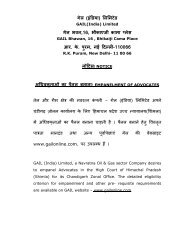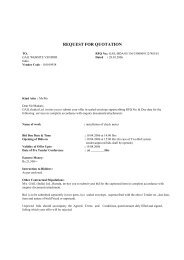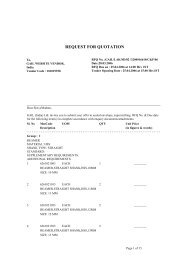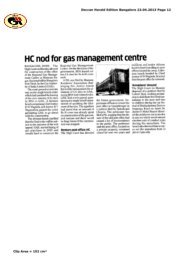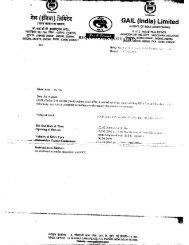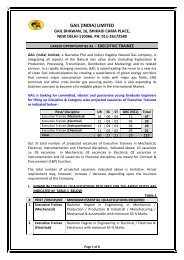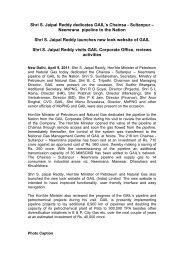GAIL (India) Limited
GAIL (India) Limited
GAIL (India) Limited
- No tags were found...
Create successful ePaper yourself
Turn your PDF publications into a flip-book with our unique Google optimized e-Paper software.
173.2 Cable laid in ground:3.2.1 All MV cables (up to 1.1 KV) shall be laid at a minimum depth of 0.75 M & HT cables (1.1 KV to 11K.V) shall be laid at a depth of 1.0 M when laid in ground. When cable pass through roads, nallahs etcthey must be protected by either hume pipe or GI pipe of suitable dimensions.3.2.2 Excavations of trenches shall be carried out as indicated in the drawing. The width of the trench at thebottom shall be 0.4 M for one cable. In case the total number of cables laid in trenches is more than one,then the width shall be such that the spacing between the cables is maintained as shown in the drawing.Before the cable is laid in the trench the bottom of the trench shall be cleared from stones and other sharpmaterials and filled with sand layers of 75 mm, as shown in the drawing.3.2.3 While removing the cable from the drum, it shall be ensured that the cable drum is supported on suitablejacks and the drum is rotated to unwind the cable from the drum the cable showed never be pulled whileunwinding from the drum. It shall be ensured that the cables are run over the wooden rollers placed intrench at intervals not exceeding 2 M3 2.4 After placing the cables in the trench shall be filled in layers ensuring that each layer is well rammed byspraying water and consolidated. The extra earth shall be removed from the place of trench and depositedat a place as directed by the Engineer-in-Charge/consultant,3.2.5 The HT cables shall be provided with RCC slabs (marked HT cable) on top as protection.3.3 Cables laid in built up trench:3.3.1 Before the commencement of cable laying the cable trench shall be drained properly Cable shall be laid asexplained in item 3.2. Cable shall be properly clamped to the cable supports, which are provided in thecable trench. The method of clamping shall suit the size of the cable and the cable supports, which areprovided in the cable trench. The method of clamping shall suit the size of the cable and the cablesupports as directed by the Engineer-in-Charge Care shall be taken while removing and replacing thetrench cover slab. It is responsibility of the contractor to make good any damaged trench covers.3.4 Cable terminations and straight through joints:3.4.1 All cable-jointing materials such as straight through joint boxes, cable compound, cable lugs insulationtapes etc. shall be of best quality and as approved by the Engineer-in-Charge.3.4.2 Cable glands for strip / armored cables shall include a suitable armor clamp for receiving and securelyattaching the armoring of the cable in a manner such that no movement of the armor occurs when theassembly is subjected to tension forces.The cable gland shall not impose on the armoring, a bending radius not less than the diameter of the cable.The clamping ring shall be solid and of adequate strength.Provision shall be made for attachment of an external earthing bond between the metallic covering of thecable and the metallic structure of the apparatus to which the cable box is attached.3.5 Sealing boxes:3.5.1 A sealing box irrespective of the class of insulation of the cable, for which it is intended, shall be sodesigned that it may be filled with compound after connecting the cable especially in flameproof/hazardous areas.3.5.2 “All parts and connection for attaching the armouring, wiping or clamping the metallic sheath in a sealingbox, shall be easily accessible. This may be achieved by splitting the box or by providing a suitable coveror other such means.3.5.3 The joints in the box shall prevent leakage of the compound.




